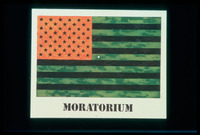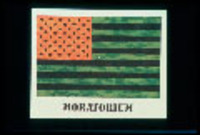| dc.description | "By contrast, Jasper Johns successfully created a powerful and unambiguous political poster. Johns frequently used the American flag in his early work but, according to Johns, not for political reasons. The flag was just another image like a U.S. map or numerical digits through which he could explore formal esthetic ideas such as texture, value and color. For example, in Flags, from 1965, Johns painted the American flag twice, the upper image in the flag's complementary colors, green, black and orange, and the lower image in gray (Figure 6). A dot is painted in the middle of each flag. If the viewer stares at the dot in the top flag for a few minutes and then moves their gaze down to the gray flag, an afterimage of the flag will appear in its true colors of red, white and blue. In 1969, Johns was commissioned by the Leo Castelli Gallery to design a poster to rally interest in the first Moratorium Day, an organized protest against the Vietnam War. Johns appropriated the earlier painting for the poster. He reproduced the green, black and orange flag and stenciled the word "Moratorium" underneath (Figure 7).
This flag, which was originally painted to demonstrate an optical illusion, has been transformed into a symbol of war protest. The colors are now sickly, representing an ailing America and the white dot alludes to a bullet hole. This work was reproduced by the thousands through commercial print methods and, according to Deborah Wye, Chief Curator of Prints at The Museum of Modern Art in New York, "The poster was distributed widely and became one of the most well known images of the (Vietnam) period" (69). Approximately one hundred copies were signed by Johns and sold to raise funds for protest activities. Although the print had a vast impact in the political arena, it is not representative of Johns' work. A reproduction for political purposes was not something Johns had ever done before and he never attempted it again. In this case, Johns was able to successfully step outside the art gallery into the street to create work designed to raise society's consciousness." -- From : http://users.rcn.com/erebora/debora/transform.html
(accessed 10/6/03) | en_US |


